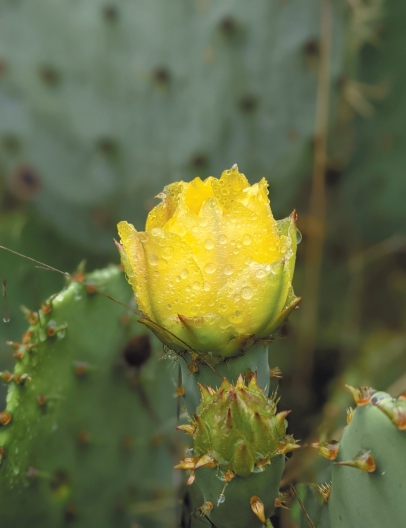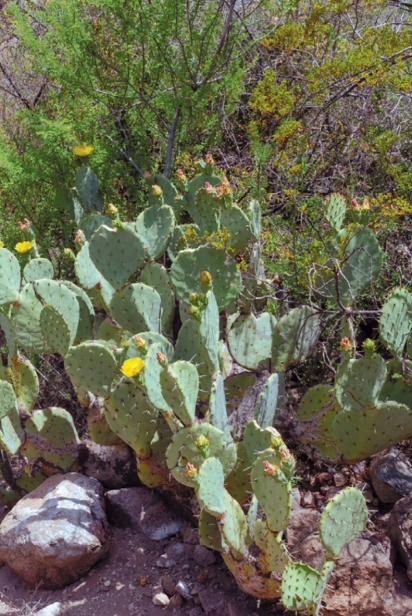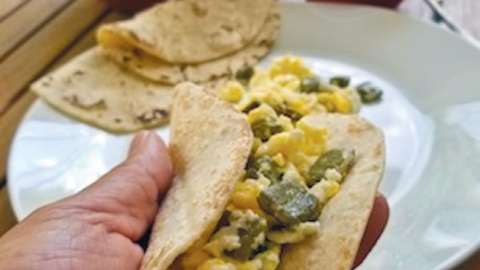Love Me Some Nopalitos
An indigenous food rooted deep in Texas Mexican food traditions
On a hot but pleasant day in April, the cacti in Big Bend National Park were bursting with bright yellow flowers. Even the big, pale green paddle-like pads looked happy, perked up from the light rain the night before. We paused at an outlook on the hiking trail for a sip of water and a nibble of dried fruit. As the cool water quenched my thirst, I thought about the trailside signs that provided information on the indigenous foods that grow in this high desert and sustain its inhabitants. With the right knowledge and skills, there was a plethora of edible fruits, leaves and roots to forage from between the sharp rocks, thorny branches and spiny leaves.
That blooming cactus is a prime example. It’s an Opuntia ficus-indica, better known as prickly pear cactus (after the fruit) or nopal (after the edible pads). Its glorious spring flowers transform into sweet, fig-shaped fruit that are ripe for the picking in late summer. But the fruits are not the cactus’s only delight. When young, the fleshy cactus pads are bright green and tender, and they are delicious in many preparations, whether raw in salads, grilled like a steak or stewed with chiles. (Note: The older, pale green pads are too tough to eat.)
Celebrated chef, food writer and filmmaker Adán Medrano has cactus in his culinary DNA. Medrano grew up in San Antonio and his ancestral roots are deeply planted in south Texas and northeast Mexico.
“I grew up with nopalitos. We cooked them at home, and to this day they are a delicious part of my food consumption,” he said. He used to watch as his mother, Dominga Mora Medrano, expertly wield a machete to harvest cactus pads. He adds, “They grew everywhere. You cut them off when they are young and tender, and then [my mother] sat in the backyard and lopped off the spines over newspaper. It is quite a technique.”
The son of migrant farmworkers, Medrano spent his childhood summers until he was 16 in the truck that his father, Juan Medrano, drove to wherever farmhands were needed. They hoed sugar beets in Iowa, picked apples, cherries, green beans, peaches and strawberries in Minnesota and Michigan and cotton closer to home, in Plainview, Texas. For the skilled farmworkers, cutting cactus pads for their own consumption at home in south Texas was routine.
“Nopalitos are a culinary gem,” says Medrano. “The flavor is unique and fresh, and there is nothing like it. I like the tart, herbal flavor they have. I call it a green flavor.” Calling them nopalitos, the diminutive form of nopales, is a term of endearment, and it emphasizes the unique place cactus has in the cuisine of the people where this prickly spined vegetable thrives.
“If anyone wants to talk about Texas Mexican food, cactus is part of that,” says Medrano, who has spent many years exploring and documenting the indigenous roots of his native Texas Mexican cuisine. He refers to the cuisine’s home as the Texas Mexican triangle, a region that embraces both sides of the Rio Grande. As Medrano says, “The river [U.S.–Mexico border] doesn’t make a difference. Brownsville or Matamoros, it is the same food.”
This regional foodways, which is different from Tex-Mex, embraces oral stories, recipes and cooking techniques (such as using an earth oven) that are passed from one generation to the next, and utilize regional ingredients including game meats and indigenous plants. Nopal, too, is native to the region.
“My mother always used native ingredients,” says Medrano. “She understood she was narrating our identity.”
Homemade tortillas heated on an open fire and mounded with freshly picked nopalitos sautéed with local onions is food that is rooted in this tradition and place. “People have been eating nopalitos tacos [here] for breakfast for thousands of years, seasoned with salt from the salt lakes of Texas and onions that grow right here.”
For Victoria Elizondo, chef-owner of Cochinita & Co. in Houston, fresh and preferably local ingredients are key to her vibrant and flavorful Mexican food. At her restaurant in the Greater East End, as well as her food truck Cochi’s Taqueria, she usually has several dishes featuring nopales on her menu. One of her creative standouts is whole grilled cactus pad, served as a taco topped with black bean spread, caramelized onions, peppers and a tangy tomatillo salsa.
When she was 12, Elizondo left her native Nuevo Leon, south of the Texas Mexican border, with her mother to move to the United States, where she became a DACA recipient. Living in a big city like Houston, she and her mom, a working single mother, didn’t get to pick their own cactus pads. Instead, they bought them at the market.
“I remember going to the market with my mom, watching the ladies at their stands peel stacks of them so super-fast that it felt they did like a hundred of them in a second,” she says. She still goes to the Houston Farmers Market (which at that time was often referred to as Canino’s) on Airline Drive, to purchase the nopales she needs.
“At my grandparents’ ranch [in China, Nuevo Leon, Mexico], I would see my aunts slicing the paddles with a big machete, and then use a potato peeler to peel off the needles,” she says. She confesses that she didn’t like them much as a child, but that changed. “I learned to love them and started creating many different dishes with them.” Her salad made with nopales, jícama, corn, tomatoes and green onions dressed with an herb-rich vinaigrette, heaped on a crunchy tostada, exemplifies her current affection and appreciation for this healthy vegetable.
“Nopales have always been a staple in our everyday food,” says Elizondo. “Now my mom is more into health since she was diagnosed with diabetes, and she makes smoothies and green juices with them.”
Using nopales for their health benefits follows ancient traditions. The cactus is high in fiber, high in calcium and full of antioxidants. Moreover, cactus has antiviral properties and may help lower bad cholesterol and regulate blood sugar levels. When we talk about this cactus as a superfood, Medrano discusses a practice that was passed through generations: “You cut up cactus, soak it in water for at least an hour, and then drink the nopal water” that is now infused with all goodness that comes from the cactus. Apparently, it can also help prevent hangovers, provided you drink the nopal water prior to alcohol consumption.
Prickly pear cactus has been offering its delicious, nutritious fruits and young pads well beyond the Texas Mexican triangle, even to people living in other parts of the world. Over time, as people traveled between continents, so did this tasty cactus. Returning conquistadors brought it to Spain as early as the 16th century. Traders took it all the way to Australia. Today, prickly pear cactus is growing in semi-arid rocky regions around the world. It thrives in balcony pots in Greece and botanical gardens in the south of France. Street vendors in Egypt sell prickly pears from donkey-drawn carts.
Or, as Medrano discovered at the Yorkshire Dales Food & Drink Festival in England in 2019, when you can’t find fresh cactus, you can get it canned. “Of course, in Texas [nopales] are so readily available, there is no need to buy them brined or vacuum-wrapped.” At the festival, he used cactus from a can to use for his gorditas filled with shrimp and nopalitos cooked in red chile. He found the canned version surprisingly good, and realized something:
“Food has no nationality. It has roots. It reminds us of a place and connects us.”
Cactus to Kitchen
Nopales are fleshy and flat, and when they are bought at a market or grocery store the spines have usually already been removed. They are easy to cut or slice. When cut, the glossy interior resembles aloe vera. They are naturally juicy and crunchy and have a refreshing, green taste with hints of tartness and salinity, as well as an okra-like mucilage. They are a nutritional treasure and quite versatile. There are many ways to prepare them. Here are a few suggestions:
Salad: Thin-sliced raw nopales mix well with fresh lime juice, cilantro, sliced onion and perhaps a little jalapeno or serrano for heat.
Stew: Simmer cut cactus pieces in a (homemade) sauce rich with ancho, guajillo and/or other red chile peppers.
Steak: Grill nopales whole, like steak, over charcoal (add mesquite or pecan wood to enhance with smokey flavors).
Breakfast: For a classic Texas Mexican breakfast, sauté cut nopales with onions then scramble with eggs, simply seasoned with salt, and wrap in a heated corn tortilla.
Don’t like the sliminess? Heat up a skillet, add cut nopales and cook for about 15 minutes. The slime evaporates.
Where to Eat Nopalitos
Our picks to get a great taste of nopalitos in Houston:
Arnoldo Richards’ Picos: Huevos revueltos con nopales al guajillo (scrambled eggs with sautéed cactus pad in guajillo chili sauce), which is found on the the breakfast menu
La Vibra Tacos: Nopal grilled with onion, garlic and guajillo chili oil (optional Oaxaca cheese)
Cochinita & co.: Nopalitos chilaquiles
Adán Medrano is the author of cookbooks Truly Texas Mexican: A Native Culinary Heritage in Recipes and Don’t Count the Tortillas: The Art of Texas Mexican Cooking. He is the maker of the film Truly Texas Mexican now available via Amazon Prime.








